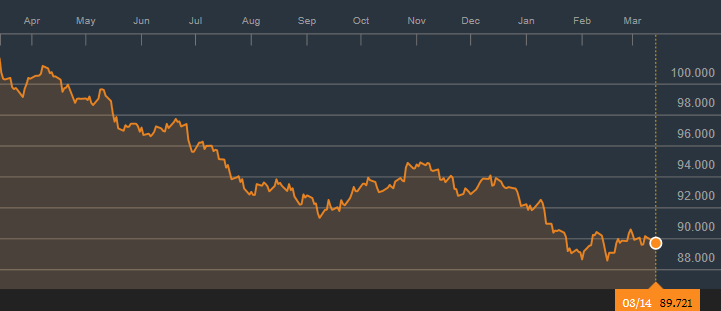Defying Economic Rationale, The U.S. Dollar Continues To Slide
Given all the pro-growth policy developments over the past year, the US dollar’s steady tumble sticks out like a sore thumb. Over the past 12 months, the dollar has lost about 8% against a basket of currencies represented by its major trading partners. This should not be the case, according to conventional economic thinking.
Figure 1 US Dollar Index March 2017-2018

By all accounts, the U.S. dollar should have received a considerable boost from several different quarters:
- A tax cut bill that was designed, among other considerations, to stimulate capital inflows, now that there is a level playing for U.S.-based domestic corporations;
- A tax bill that encourages the repatriation of dollars stored overseas in U.S.- based multi-nationals;
- Higher long-term interest rates compared to those in Japan and the EU; such rate differentials should encourage greater flows of portfolio and direct investment into the United States; and,
- New, higher tariffs that are aimed at encouraging foreign enterprises to jump the tariff wall and re-locate in the United States
The irony is that Trump’s “American First” policy has not stemmed the dollar slide as expected. Americans have always taken pride in the strength of their currency worldwide, yet all these policy thrusts have had no impact on reversing recent trends.
Barry Eichengreen, Professor of Economics at the University of California, Berkeley, asked himself the same question.[1] He went through a litany of possible explanations. One explanation considered the possibility that the Fed is way behind the curve in not raising interest rates fast enough to ward off inflation. That is, rates should be higher than they are now and that would attract demand for the currency. Given that inflation is quite tame, he does not believe Fed policy lies at the core of why the dollar languishes.
Another set of explanations he looked at included:
- an infrastructure bill turns out to be very small and almost impossible to implement;
- initial withdrawal from the Trans-Pacific Partnership trade agreement, only to undergo a re-evaluation a year later:
- the flip-flop behavior of the U.S. Treasury secretary from, initially, advocating a weak dollar to now embracing a strong-dollar policy.
He boils everything to one basic explanation--- tremendous uncertainty,
“And there’s nothing investors like less than uncertainty. This is especially true of investors in a currency whose strongest attraction is its safe-haven status. Investors traditionally flock to the dollar not simply because it is stable, but also because it tends to strengthen in a crisis, given that its issuer has impregnable defenses and possesses the deepest and most liquid financial markets in the world.”
Eichengreen stresses that continued chaos in the White House will only depress the dollar further. The chaos seems unabated with each passing day.
[1] https://www.project-syndicate.org/commentary/what-explains-dollar-weakness-by-barry-eichengreen-2018-03/english




Fiscal irresponsibility by cutting taxes and not expenses does a lot. If you add a trade war and get an uptick in inflation then it can look even worse. People should be looking at this more than oil and the stock market. What has happened is quite clear and it is cutting into Americas wealth much worse than anything else. Certainly the economic growth is not outweighing the purchasing power devaluation we are seeing.
A set of very destructive policies all combining at the same time